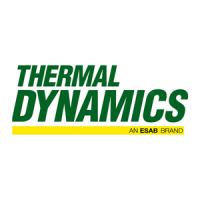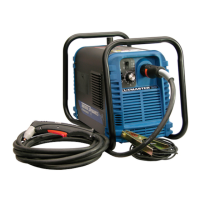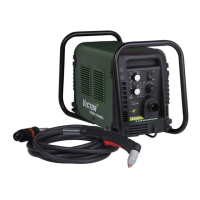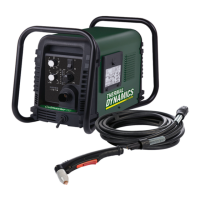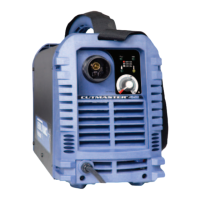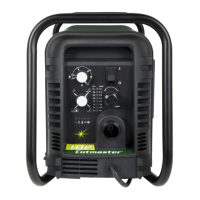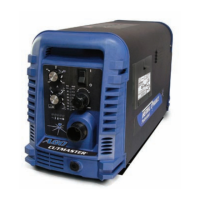Manual 0-2898 4-1 TROUBLESHOOTING
SECTION 4:
TROUBLESHOOTING
4.01 Introduction
This section provides service diagnostics for the CutMas-
ter 38 Power Supply, allowing the Technician to isolate
any faulty subassemblies.
Under no circumstances are field repairs to be attempted
on Printed Circuit Boards or other subassemblies of this
unit. Evidence of unauthorized repairs will void the fac-
tory warranty.
NOTE
This manual covers the Power Supply only.
Troubleshooting other parts of the system is cov-
ered in separate manuals for those products.
4.02 Periodic Inspection & Cleaning
Procedures
This subsection describes inspection procedures which
should be performed at periodic intervals as required.
A. Physical Inspection
Check that all wiring connections are secure.
B. Cleaning
Open the enclosure and use a vacuum cleaner to re-
move any accumulated dirt and dust. The unit should
also be wiped clean. If necessary, solvents for clean-
ing electrical apparatus may be used.
Refer to Appendix for maintenance schedule and pro-
cedures. Clean or replace filters per Section 5.07.
4.03 System Design
The CutMaster 38 System is designed for hand cutting
only.
4.04 Common Operating Problems
WARNINGS
Disconnect primary power at the source before dis-
assembling the power supply, torch, or torch leads.
Frequently review the Important Safety Precau-
tions in Section 1 of this manual. Be sure the op-
erator is equipped with proper gloves, clothing, and
eye and ear protection. Make sure no part of the
operator's body comes into contact with the work-
piece while the torch is activated.
Sparks from the cutting process can cause damage
to coated, painted, and other surfaces such as glass,
plastic and metal.
Handle torch leads with care and protect them from
damage.
A. Piloting
Piloting is harder on parts life than actual cutting be-
cause the pilot arc is directed from the electrode to
the tip rather than to a workpiece. Whenever pos-
sible, avoid excessive pilot arc time to improve parts
life.
B. Torch Standoff
Improper standoff (the distance between the torch tip
and workpiece) can adversely affect tip life as well as
shield cup life. Standoff may also significantly affect
the bevel angle. Reducing standoff generally results
in a more square cut.
C. Edge Starting
For edge starts, hold the torch perpendicular to the
workpiece with the front of the torch tip at the edge
of the workpiece, not touching, at the point where the
cut is to start. When starting at the edge of the plate,
do not pause at the edge and force the arc to “reach”
for the edge of the metal. Establish the cutting arc as
quickly as possible.
D. Direction of Cut
The plasma gas stream swirls as it leaves the torch.
The purpose of the swirl is to maintain a smooth col-
umn of gas. The swirl effect results in one side of a
cut being more square than the other. Viewed along
the direction of travel, the right side of the cut is more
square than the left.
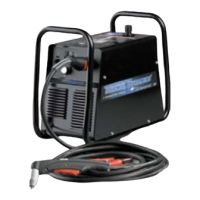
